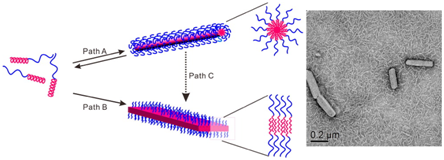 Research Progress
Research Progress
- Oxidation-responsive OEGylated poly-L-cysteine and solution properties studies
- Effects of the surface charge on the stability of PEG-b-PCL micelles: simulation of the interactions between charged micelles and plasma components
- Supramolecular Hydrogels Assembled from Nonionic Poly(ethylene glycol)-b-Polypeptide Diblock Containing OEGylated Poly-L-glutamate
- Surface-Induced Hydrogelation Inhibits Platelet Aggregation
- Stimuli-responsive polypeptide materials prepared by ring-opening polymerization of α-amino acid N-carboxyanhydrides
- Effects of molecular weight on thermal responsive property of PEGylated poly-L-glutamates
- Facile Synthesis of Dendrimers Combining aza-Michael Addition with Thiol-yne Click Chemistry
- Peptide Hydrogels Assembled from Nonionic Alkyl-polypeptide Amphiphiles Prepared by Ring-Opening Polymerization
- SYNTHESIS OF TOOTHBRUSH COPOLYPEPTIDES BASED ON POLYLYSINE BACKBONE
- One-step synthesis of water dispersible silica nanoplates
- Conformation-specific Self-assembly of Thermo-responsive Poly(ethylene glycol)-b-polypeptide Diblock Copolymer
- Coassembly of Poly(ethylene glycol)-block-Poly(glutamate sodium) and Gemini Surfactants with Different Spacer Lengths
- Thermoresponsive Oligo(ethylene glycol) Functionalized Poly‑L‑cysteine
 Conformation-specific Self-assembly of Thermo-responsive PEG-b-polypeptide Diblock Copolymer
Conformation-specific Self-assembly of Thermo-responsive PEG-b-polypeptide Diblock Copolymer
Conformation-specific Self-assembly of Thermo-responsive Poly(ethylene glycol)-b-polypeptide Diblock Copolymer
Junyang Shen, Chongyi Chen, Wenxin Fu, Linqi Shi *, and Zhibo Li *
Langmuir, 2013, 29 (21), 6271–6278
Poly(ethylene glycol)-block-poly(gamma-(2-methoxyethoxy)esteryl-L-glutamate) (PEG-b-poly-L-EG2Glu) was synthesized via ring-opening polymerization (ROP) of L-EG2Glu N-carboxyanhydride (NCA) using PEG-NH2 as macroinitiator. This diblock contained a thermo-responsive poly-L-EG2Glu block, which adopted primarily helical conformation in pristine aqueous solution. We found that PEG-b-poly-L-EG2Glu diblock can display two levels of self-assembly behaviors associated with hydrophobic interactions and conformation specific reassembly, respectively. Upon temperature increase, the PEG-b-poly-L-EG2Glu diblock formed wormlike micelles, in which the poly-L-EG2Glu formed the micelle core and maintained helical conformation. However, extension of thermal annealing time drove the secondary structure transformation of the poly-L-EG2Glu block from helical conformation to beta-sheet, which accounted for an assembly structure transition from wormlike micelles to nanoribbons. The critical factor was that poly-L-EG2Glu block can undergo thermo-induced hydrophobicity and conformation transformation, which offered an additional parameter to tune the nature of molecular interactions, i.e intermolecular versus intramolecular hydrogen bonding interactions. The corresponding conformation and assembly structure changes were characterized using FTIR and electron microscopy, respectively.
